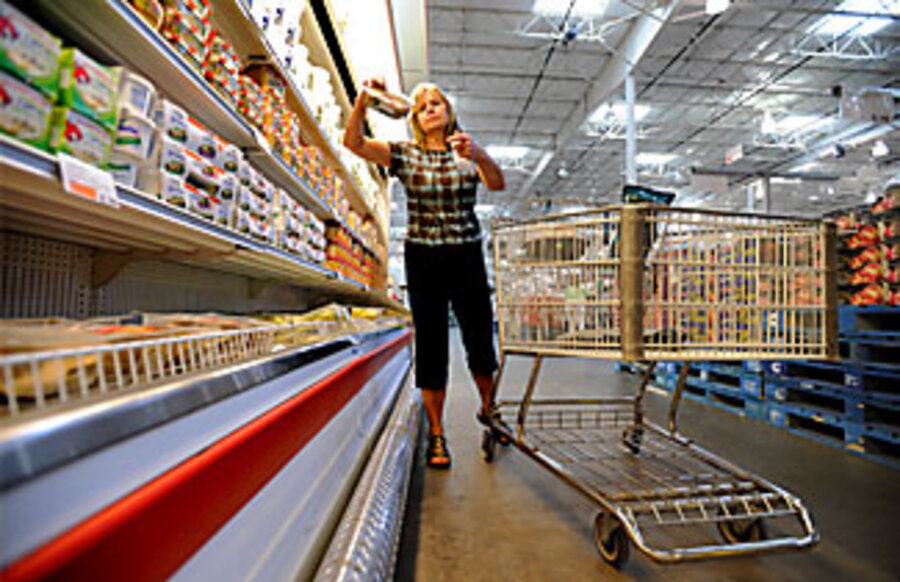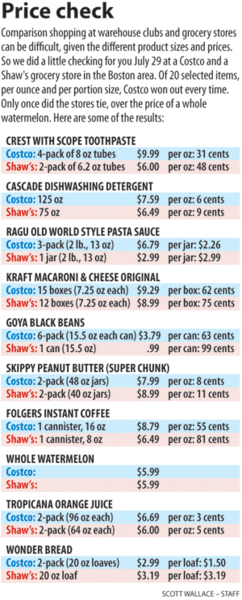Warehouse shoppers: Do you save enough to justify the trip?
Loading...
Even on a muggy day in July, its unusual to see nearly every shopper leaving a grocery store with a watermelon.
But at a Costco in Everett, Mass., the $5.99 deal on the tantalizing fruit was just too good to pass up.
Or was it?
Those shoppers might have been surprised to learn that a nearby Shaw's supermarket was selling watermelons for – you guessed it – $5.99.
During this year of sky-high food and energy prices, the only sweet spot in the food retail sector seems to be warehouse clubs such as Costco, BJ's Wholesale Club, and Sam's Club. Such stores have seen sales grow as consumers tighten their food-budget belts. Low prices helped make the 1,149 warehouse clubs in the United States a $107.5 billion industry by the end of 2007. And with consumer prices jumping 5 percent in the past year, warehouse clubs benefited, especially as consumers turned to the clubs for gasoline.
But while these clubs offer significant savings, experts say the warehouse experience can also incite unplanned spending, a situation many shoppers hope to avoid during an economic downturn.
"People like to get a deal," says Larry Compeau, associate professor of consumer studies at Clarkson University's business school in Potsdam, N.Y. "A deal has value above and beyond the money saved; there's a psychological effect," which can inspire consumers to overspend, he says.
Omar Magnusson of Malden, Mass., didn't buy a watermelon at the Everett Costco, but he did leave the store with a crate of apricots he didn't intend to purchase, admitting he regularly overbuys perishable food items.
"The salad is great – it is the best deal," he says, "but you can't eat it all in a couple of days before it starts wilting."
While Mr. Magnusson's spending may be moderate, the average amount spent in a visit to a warehouse club is $93, higher than the $38 Americans typically spend at a grocery store, says Brian Todd, president of the Food Institute, a nonprofit in Elmwood, N.J., that provides information on the food industry.
There are many reasons for this, Mr. Todd says. First, such trips are less frequent: Consumers averaged 11 trips to warehouse clubs in 2007, versus 59 trips to grocery stores. Some shoppers only make the trip to stock up on bulk items, or businesses may load up on products that they'd otherwise need a supplier to deliver. For others, he says, "There's an entertainment value to it. It's kind of an experience."
Mr. Compeau says the club's ambiance often generates the excitement over a perceived deal.
"It's very stark, open, and nothing upscale. It conveys the notion that 'We're on the cheap here' and if you walk in thinking it will cost $2,500 for a plasma TV and you see one for $1,800 – bingo – the deal is too good to pass up," he says.
Customers also understand that those deals may not be around for long.
"Wholesale clubs buy a shipment of an item and once it's gone, it's gone.... It's the opportunity to lose that deal which pushes up the time limit" and inspires some people to buy on the spot, Compeau says.
Often, prices are cheaper per unit at warehouse clubs, he says. But they aren't always less, and customers may overspend because it's difficult to comparison shop between wholesale clubs and regular grocery stores.
Some stores reveal price per unit in terms of ounces, while others in pounds, or even by package. Going between grocery store and warehouse club "takes effort, and unless you have a photographic memory, memorizing even the dozen products you buy most often is a significant task. And if you can't remember it, you have to write the product price down at one store before you go shopping in another," he says.
It's rare that even a deal-conscious consumer would shop that way, says Michael Norton, assistant professor of marketing at Harvard Business School. In fact, many shoppers are convinced they're getting a deal before they even enter a store. Mr. Norton co-wrote a study that found shoppers associate a store's membership fee with savings, independent of the actual savings the store offered.
That perception is good news for warehouse clubs, which charge membership fees ranging from $40 to $100 per year In a series of experiments, Mr. Norton and Leonard Lee, assistant professor of marketing at Columbia Business School, found that "people made an inference that there must be some discount on a product" in a store they said charged a membership fee. In their study, membership-fee "shoppers" bought larger quantities of discounted items as well as a wider variety of items than did those in an experimental store without a membership fee, but the same items and prices.
Norton likened the experiment's shoppers to warehouse shoppers who "go in meaning to buy a four-pack of toilet paper and buy a 50-pack and then also buy a case of tomato soup [they] don't even like."
Buying in bulk isn't always a bad idea, Compeau says. Shoppers probably won't roll through toilet paper any faster whether they have 30 rolls on hand or five. But overbuying food products often creates a different outcome.
"If you buy cases of soda, you're more likely to consume it faster than if you only have a six-pack," he says, adding that people consume a bounty of food more quickly than if they must conserve the same food product.
None of this means customers can't restrain themselves in warehouse clubs. Last month, Costco announced that its fourth-quarter profits wouldn't meet expectations, a sign consumers are either buying less or the costs of the operation are going up, says Hemant Sangwan, a consultant with Global Insight, a financial forecasting company.
Warehouse clubs hold down prices by keeping their overhead low, which enables them to sell goods with profit margins of 11 to 14 percent, whereas margins for grocery stores are in the 20 to 30 percent range, says Michael Clayman, editor of Warehouse Club Focus. Holding down prices has lessened Costco's profits, he says, since their suppliers have increased costs.
It's "the philosophy of the channel: Buy as much as efficiently as they can and keep the margins lower than any other retailers. It's their philosophy when the economy is doing well and when the economy is not doing so well," he says.
Now, Mr. Clayman says, warehouse clubs may look for cheaper vendors. But Mr. Sangwan says it's unlikely the clubs will significantly raise prices.
Still, consumers can avoid the spending frenzy. Compeau advises leaving a shopaholic spouse at home, and kids, too, if you tend to indulge them. Knowing your food-consumption habits and your true food preferences will also help avoid buying a huge box of iceberg lettuce when you really prefer Romaine.
And be determined.
Enter a club "with tunnel vision," Norton says. "It's very unlikely you really need something you didn't already have on a list and very unlikely you need it in that quantity. If you get out of the store and decide you need to go back and get that 100-pack of soup, you can always do so later."






